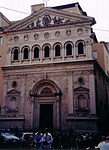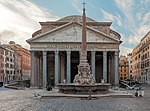Elephant and Obelisk
1660s sculpturesAncient Egyptian obelisksElephants in artMarble sculptures in ItalyObelisks in Rome ... and 4 more
Relocated ancient Egyptian monumentsRome R. IX PignaSculptures by Gian Lorenzo BerniniVandalized works of art

Elephant and Obelisk is a statue of an elephant carrying an obelisk, designed by the Italian artist Gian Lorenzo Bernini. It was unveiled in 1667 in the Piazza della Minerva in Rome, adjacent to the church of Santa Maria sopra Minerva, where it stands today.
Excerpt from the Wikipedia article Elephant and Obelisk (License: CC BY-SA 3.0, Authors, Images).Elephant and Obelisk
Piazza della Minerva, Rome Municipio Roma I
Geographical coordinates (GPS) Address External links Nearby Places Show on map
Geographical coordinates (GPS)
| Latitude | Longitude |
|---|---|
| N 41.897983333333 ° | E 12.477572222222 ° |
Address
Obelisco della Minerva (Pulcin della Minerva)
Piazza della Minerva
00186 Rome, Municipio Roma I
Lazio, Italy
Open on Google Maps










